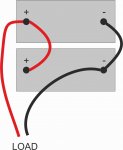Graham376
Well-known member
If anyone knows a better way of mixing batteries in parallel, please post a link or diagram, rather than negative posts and opinions.
Finally I would remind anyone constructing a large parallel battery bank that in the end using another battery selector to divide them up is definitely the way to go,
PS: I don't base my posts on anything I find in the internet, but what I try to do is provide links to confirm my opinions and to provide more information.
Having read your posts, I really can't understand where your advice is coming from. Diodes have no place in paralleling batteries and switching every battery is unnecessary and just complicates matters. The OP's question was answered in post #2, parallel them together preferably alongside each other. It is of course better if both are identical and the same age but not crucial. I speak from a few decades of practical experience, not theory, having tried most combinations of battery connection.

